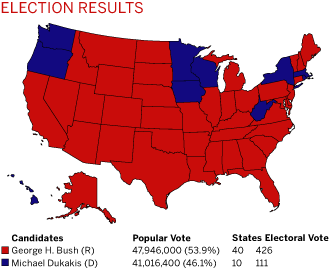Ronald Reagan—the first president since Eisenhower to serve two full terms—had presided over a renewed national optimism, but there were dark clouds on the horizon as his presidency drew to a close. The federal deficit was soaring out of control. The revelation that profits from American sales of weapons to Iran were illegally routed to the Nicaraguan contras spawned a major scandal. Wall Street was in turmoil following several insider-trading scandals and the October 1987 stock market collapse. The stage was set for one of the most bitter presidential campaigns in recent history: Vice President George Bush, who portrayed himself as the rightful heir to the Reagan revolution, versus Massachusetts Governor Michael Dukakis, who offered a traditionally Democratic vision of increased government spending on health care, child care, education, and housing. The Bush campaign used brutal television advertising to portray Dukakis as an ineffective liberal who would gut the country’s defense system and let convicted murderers out of prison. Hoping voters would dismiss the attacks as unfair, Dukakis refused to counterattack until late in the campaign. By then it was too late.
Republican
George Bush for president
Dan Quayle for vice president
"Experienced Leadership for America’s Future"
The case of Willie Horton--an African American convicted murderer who raped a white woman and tortured her fiancé while on a weekend furlough from a Massachusetts prison--was frequently mentioned by George Bush in campaign speeches. The case was directly referred to in a commercial produced by an independent political action committee. Although officially repudiated by the Bush campaign, the spot, which was broadcast only once, was widely reported in the news media and caused substantial damage to Dukakis. The Horton case was also implicitly referred to in Bush’s "Revolving Door" ad, which attacked the Massachusetts furlough program in general. Another negative commercial that has gained legendary status used news footage of Dukakis riding in a tank--grinning and looking diminutive in his oversized helmet--to ridicule the idea of him as commander in chief.
Though Bush’s negative commercials garnered most of the attention, his campaign also produced a series of strong positive ads, such as "The Future." Made in the lyrical montage style of Reagan’s 1984 spots, these ads sought to establish an identity for the two-term vice president. The main departure from the Reagan ads was that while Reagan hardly appeared in his own spots, Bush figured prominently in his. He was shown either in excerpts from his speech accepting the nomination or in family scenes that presented him as an all-American father figure.
Bush’s media campaign skillfully supplemented paid publicity (commercials) with free publicity in the form of staged photo opportunities sure to be reported as news--a technique originated by the 1984 Reagan campaign. For example, news footage of Bush receiving the endorsement of the Boston police union reinforced the law-and-order message of the furlough ads. The Bush media campaign was a model of control, supervised in all respects by veteran media consultant Roger Ailes, who also coached Bush for the debates.
Democrat
Michael Dukakis for president
Lloyd Bentsen for vice president
"The Best America Is Yet to Come"
The disarray and confusion of the Dukakis campaign was exemplified by a series of commercials known as "The Handlers." In one of these commercials, "Crazy," a group of Bush media consultants worries that their selection of Dan Quayle for vice president may have been a mistake. The intention was to portray Bush as a superficial candidate whose campaign was based more on image than on substance, but the ads were confusing and seemed at first glance to be pro-Bush. They were pulled off the air, but only after the Dukakis campaign had spent $3 million to produce and air them.
Consultants from several ad agencies came and went throughout the run of the Dukakis campaign, and the chain of command was constantly in flux. The campaign considered more than 1,000 ad scripts during a three-month period, and the ads produced were inconsistent in style and devoted almost exclusively to defending against Bush’s attacks. There were no strong ads linking Bush to Panamanian dictator Manuel Noriega, even though Dukakis repeatedly brought up the connection in speeches and debates, or to the Iran-contra arms-for-hostages deal. Most critically, Dukakis failed to respond to the Willie Horton attack until late in the campaign, when he finally aired a counterassault called "Furlough from the Truth."
Like Mondale in 1984, Dukakis never forged a positive identity in his ads. In his speech accepting the nomination, he had movingly described himself as the embodiment of the American dream, a son of Greek immigrants who was more in touch with the people than George Bush. Inexplicably, this message was almost completely absent from his advertising.
